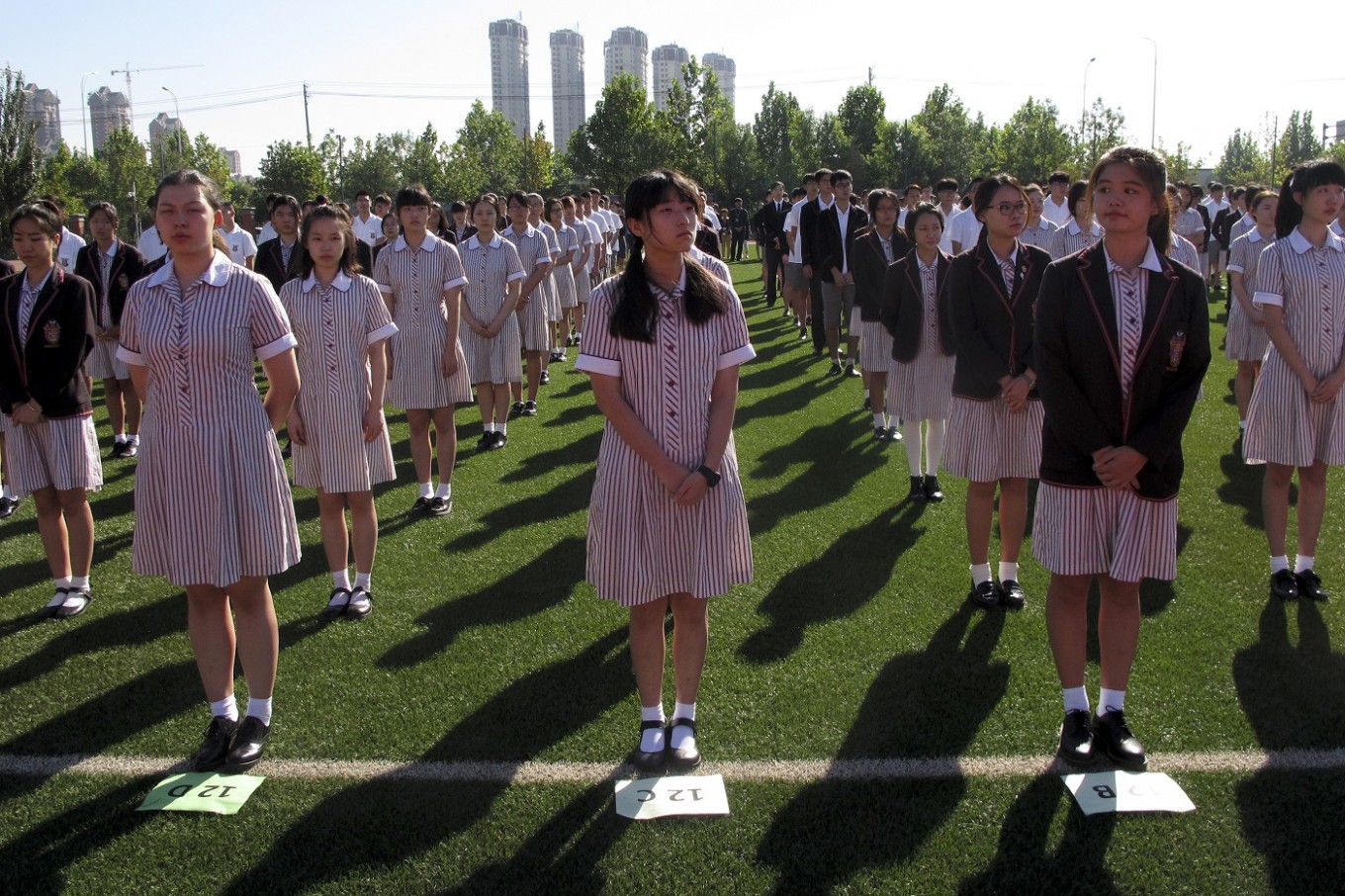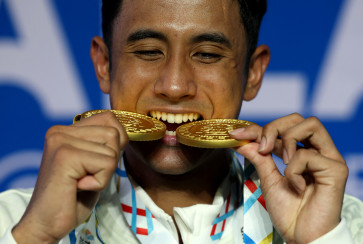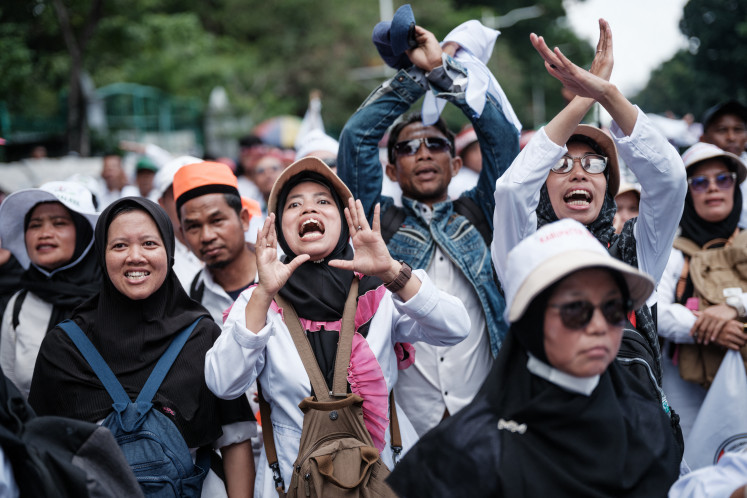Popular Reads
Top Results
Can't find what you're looking for?
View all search resultsPopular Reads
Top Results
Can't find what you're looking for?
View all search resultsChina's demand for pricey international schools 'insatiable'
Change text size
Gift Premium Articles
to Anyone
T
he school year at Haileybury College's campus outside Beijing began with three People's Liberation Army soldiers marching on a running track as the Chinese national anthem played over loudspeakers. Seven hundred students stood silently in single-file lines, their hands crossed, the international prep school's crest emblazoned on many of their coats and T-shirts.
Then they sang the school song in English before heading off to class in brick-facade buildings modeled on a British prep school.
For most Chinese students, attending a school like this remains unthinkable. But international schools from abroad are booming here thanks to growing demand from parents who are seeking different pathways for their children to attend college overseas, and who can increasingly afford more options. Top prep schools from around the world are opening campuses in the country, often charging higher fees than their flagships and catering to students who want to go to university in the West.
Attending Haileybury costs up to $28,000 a year. But Haileybury, which opened the Chinese version of its century-old Australian prep school three years ago, nearly doubled its enrollment this year and is considering opening a second campus in China.
Getting into China's best public high schools can be monumentally difficult, but regardless of whether their child has the academic chops, many parents are opting to pay for what they see as a less stressful and more enriching experience at an international school.
"What they really care about is the happiness of their children," said Wang Dan, an education professor at the University of Hong Kong. "Their future return on the student's education is one concern, but equally important is the concern for the learning process."
The International School Consultancy, which monitors school trends worldwide, says the demand among Chinese for English-language schools like Haileybury is "insatiable." More than 150,000 Chinese students are currently enrolled in international schools, according to the consultancy, which says the number of Chinese who can afford to pay seemingly stratospheric fees for those schools — even if it's just a small percentage of the country's population — will continue to grow, absent a dramatic downturn in China's economy.
China's top public high schools are intensely competitive and often criticized as excessively test-driven. Before their teenage years, children study long hours for entrance exams, often with high-priced private tutors. And at the end of high school, students take the notoriously difficult Chinese college entrance exam, the Gaokao, where a bad score can relegate a good student to a lesser university.
A massive government-ordered expansion of higher education over the last decade has produced many marginal colleges whose degrees count for little. That makes an overseas education even more attractive.
Western prep schools in China advertise a smoother pathway to university overseas, with teaching that emphasizes critical thinking over memorization and classes based on the International Baccalaureate program or others recognized abroad.
Once limited mainly to foreign children, international schools have been allowed during the last two decades to open campuses for Chinese students jointly with local companies. And while the Chinese government has sought to tighten its ideological control over textbooks and limit perceived Western influences, the international schools offer a valuable infusion of new teaching methods and options for China's middle class.
(Read also: Life in an international school in Jakarta)
That opening has brought in some of the world's biggest brand names, joining long-established international schools in Beijing and Shanghai. Britain's Dulwich College now runs schools for Chinese students in the eastern city of Suzhou and the southern city of Zhuhai; Britain's Hurtwood House operates in association with a school in eastern Ningbo.
William Vanbergen, managing director of the Shanghai school consulting firm BE Education, predicts many more Western schools will enter China in the coming years. Some schools are already struggling to maintain their enrollment, but for most, China presents a "fantastic opportunity" to build a global profile, he said.
"Chinese parents are very smart," Vanbergen said. "They demand the very best, and it's going to become quite clear which operations are good and which are not."
Haileybury established its first program in China in 2001. Nick Dwyer, the school CEO, said the school's executives had long been seeking a local company with which to partner on its own campus.
"It's a tough ask for any student to go as a foreign student to another country," Dwyer said. "Here, we are offering the Australian product tailored in such a way that the Chinese students are at the center of the project, not off to one side."
Eventually, the school reached a deal with a state-owned development company to build a tree-lined campus between Beijing and the port city of Tianjin, featuring a towering administration building with two turrets that's a replica of London's Eton College prep school.
The campus anchors a development of high-rise residential towers and single-family homes. Haileybury leases the campus and charges higher tuition in China than in Australia.
Dwyer described the school as Australian in its traditions, presented "in Chinese dress." Teachers give lessons in both English and Chinese, and events like its opening ceremony are adaptations of Australian assemblies. Hallways are marked as "English-speaking zones." The school offers a modified version of the standard Chinese curriculum until high school levels, and then classes based on Australia's Victoria Certificate of Education.
Haileybury's first class of about 25 students graduates this fall. Their success will be a huge test for the school, Dwyer said. For the school to be successful, he said, every graduate must be admitted into college or a prep school en route to college.
"Most of them must get a pathway into university, and the rest of them must get a pathway that they will transition into university," Dwyer said.
But already, Haileybury is successfully recruiting new families and moving toward profitability. Dwyer said he expects to break even this year.
Cheng Rui, a marketing consultant in Beijing, was touring Haileybury last month with his 9-year-old son. Cheng had enrolled his son previously in a bilingual program sponsored by a top Chinese university. But he saw his son feeling constant pressure and not being able to communicate with foreigners on a family vacation to the United States and Canada, despite having taken English classes in school.
"It will be more enriching and distinctive for him in terms of developing his interests, and he will be under less pressure than students at traditional Chinese schools," Cheng said.
"I wish to see him develop at his own pace," he added.
While China's economic boom has allowed millions of families to afford options like Haileybury, international schools remain out of reach for the vast majority of Chinese.
Zeng Xiaodong, a professor at Beijing Normal University, said she understood that parents who could afford those schools were seeking a pathway for their children "to understand the future and be a member of the international world." But those options remain closed to rural families and don't solve the inequity of the overall system, she said.
Wang, the University of Hong Kong professor, said China's overall system may eventually benefit from the introduction of new teaching methods by international schools. But for now, particularly in rural areas, poor and even many middle-class children don't have access to better teaching, while upper-middle-class children are increasingly learning in a separate system.
"The inequality of China right now is really dividing the population, and each group is playing a different game," she said.
___
Associated Press videojournalist Thomas Suen and researcher Yu Bing contributed to this report.







